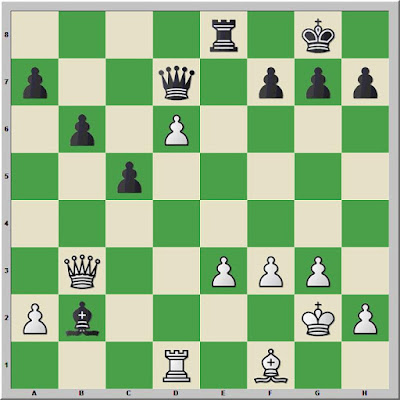I have been playing correspondence chess on ChessWorld.net for eleven years, longer than any other site where I play at present. It was the third website that I joined for this sort of chess. First was Net-Chess.com in early 2003. Then GameKnot. Ironically, someone in the forums at GameKnot alerted me to the existence of ChessWorld.net. Someone alleged that ChessWorld.net was created by a disaffected former GameKnot member and that CW was inferior to GK. I decided to take a look for myself.
ChessWorld.net is vastly superior to GameKnot in my opinion. The site design is more robust and users have far more options for tweaking the interface. A nice feature of CW that I have not found on other sites is pie charts showing a player's performance.
 |
| My Performance |
Pie charts for various rating groups shows how I have performed against those rated higher than me.
 |
| Performance Against 1800+ |
My third earned victory over a player above 2280 ended last night. The game began at the end of July 2014. My opponent played the Budapest Gambit, an opening that has given me trouble over the years.
I only checked two positions in my annotations with Stockfish.
Stripes,J (2202) -- Internet Opponent (2355) [A51]
www.ChessWorld.net, 31.07.2014
1.d4 Nf6 2.c4 e5 3.dxe5 Ne4
3...Ng4 has given me trouble in a few games.
4.Nf3 d6 5.Nbd2 Bf5 6.Nxe4 Bxe4
White to move
7.Qb3N
7.Ng5 has been played in a couple of games, and is the engine's choice. I had the notion to play this move next. 7...Bg6 8.e6 fxe6 9.Nxe6 Qd7 10.Nf4 led to a win by White in 42 moves in Veingold,A (2465) -- Carpintero,J (2265), Linares 1994.
7...Bxf3 8.exf3
8.Qxf3 Nc6 9.exd6 Bxd6 struck me as offering Black good compensation for the pawn. Instead, I wanted to get my pieces into play. I was spending a lot of time on Paul Morphy's games during this phase of the game. That probably influenced my decision.
8...b6 9.exd6 Bxd6 10.Be2 0–0 11.0–0 Re8 12.Be3 c5 13.Rad1 Qc7 14.g3 Nc6 15.Rd5 Rad8 16.Rfd1
Both players have completed their development, as the classicists say.
Black to move
16...Ne7 17.R5d2 Nf5 18.Bf1
Removing the bishop as a potential target so my rooks would be free to roam on the d-file.
18.f4 was an alternative.
18...Nxe3 19.fxe3 Be7 20.Rd5 Bf6 21.Kg2 Qe7 22.Qd3
Black to move
Offering the b-pawn. I was willing to trade rooks if I also could swap queens and keep an extra pawn.
22...Rxd5
22...Bxb2?? 23.Rxd8 Qxe3 (23...Rxd8 24.Qxd8+ Qxd8 25.Rxd8#) 24.Qxe3+-.
23.cxd5
I like having a passed pawn backed by heavy pieces.
23...Bxb2?
I am not certain that this move was Black's most significant error, but my road to victory seemed relatively uncomplicated afterwards. I had to attend to simple tactics and a lot of queen maneuvers.
23...Rd8 24.d6 Qe6 25.b3 Be5 26.d7 and White's advantage seems less significant.
24.d6 Qd7
24...Qf6 25.d7 Rd8 26.Qe4 Kf8 27.Bb5 Qe7 28.Qxh7 g6 29.Qh6+ Bg7 30.Qf4±.
25.Qb3
Black to move
A fork of piece and square.
25...Re6
25...Bf6 26.Bb5+-.
26.Qxb2+- Rxd6 27.Rxd6 Qxd6
I would like to trade queens, but my opponent understands this goal and refuses to cooperate. As long as his queen remains, he has the chance, however remote, to force a draw by repetition or even to sneak in a checkmate.
28.Qc2 Qe7 29.Qd2 g6 30.Kf2 Kg7 31.e4 h5 32.h4 Qe6 33.Qd5 Qe7 34.f4 f6 35.Bc4 Qe8 36.Ke3 a6
White to move
37.Qb7+!
Another fork. This move eliminates Black's chances for counterplay with his queenside pawns.
37...Kh6 38.Qxb6 f5
Decision time.
White to move
39.Qxc5
I was willing to suffer some checks, secure in the knowledge that my queen and bishop were well positioned to weave a mating net once Black had driven my king to h3. Of course, I had to verify that my opponent would not have a free move to play Qh1#!
39...Qxe4+ 40.Kf2 Qc2+ 41.Kg1 Qc1+
I expected 41...Qb1+ 42.Kh2 Qb2+ 43.Kh3 Qb8.
42.Kg2 Qc2+
Still expecting 42...Qb2+ 43.Kh3 Qb8.
43.Kh3 Qc3
43...Qe4 44.Qf8+ Kh7 45.Bg8+ Kh8 46.Bf7+ Kh7 47.Qg8+ Kh6 48.Qh8#.
44.Qf8+
Black to move
44...Kh7
44...Qg7 45.Qxg7+ Kxg7 46.Bxa6+-.
45.Bg8+ Black resigned 1–0
I had played relatively slowly through the first 25-30 moves and had lost the other game with this opponent on time because I failed to log in one weekend. The game was seven days per move. My opponent had slowed down and played each move this summer when he was under twenty hours remaining.
After playing 45.Bg8+, I left him a note with the moves to checkmate. With one day remaining on the clock, he resigned.





















No comments:
Post a Comment